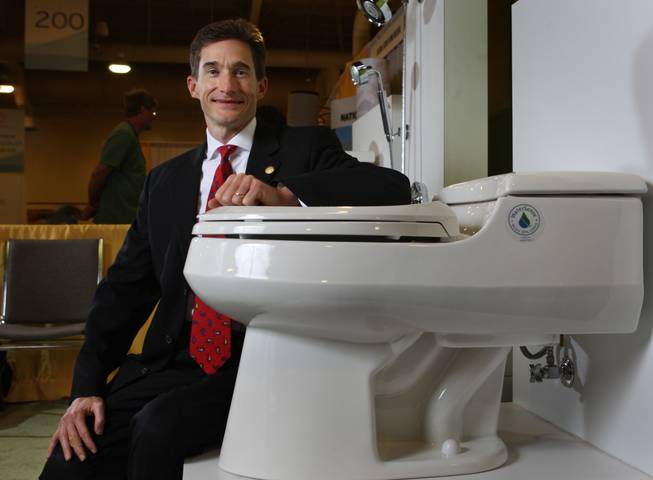
Benjamin Grumbles says 30 percent of indoor water use is from toilets, so he aggressively promotes the use of new toilets that consume less water He also says consumers should pay more — the “true” cost — for water.
Monday, Nov. 24, 2008 | 2 a.m.
Sun Topics
Benjamin Grumbles, the Environmental Protection Agency’s assistant administrator for water, has a lot of pictures of himself with toilets.
That’s because Grumbles promotes low-flow toilets and other water-saving devices through EPA’s WaterSense program. He was in Las Vegas for October’s WaterSmart Innovations conference, where the Sun caught up with him.
How are the energy and water crises connected?
Water efficiency and energy efficiency are inextricably connected because products that save water also save energy and money. And a big part of the WaterSense program is helping people connect the drops and the watts.
What is the most important water-saving invention of the past 10 years?
High-efficiency toilets. They use less than 1.3 gallons per flush and work much better than their older counterparts, saving at least 20 percent. The WaterSense program focused on toilets first because the old water-guzzling toilets waste 900 billion gallons of water a year in the U.S. Thirty percent of indoor water use comes from toilets, which are the largest consumer of water in the American household.
What inventions have mattered most in the Southwest?
Water-efficient irrigation systems. National average outdoor water use is 30 percent. Here it’s at least 70 percent.
Are you optimistic about the future of water supplies in the Southwest?
I am optimistic that the global awareness of climate change and the connection between energy and water will fuel the water efficiency movement. American citizens, businesses, entrepreneurs and utilities see the need to reduce demand to preserve America’s greatest liquid asset. It’s a cliche, but water is the oil of the 21st century.
How serious a problem is the country’s aging water infrastructure?
This country has a water system that’s the envy of the world, but it is getting old. Water and wastewater treatment plants are aging while populations grow and environmental standards get stricter. For the EPA it’s a priority.
How will the high costs to improve the nation’s water and wastewater systems be covered?
One key will be charging consumers the true, higher cost of water, although it’s a politically difficult message to deliver.

Join the Discussion:
Check this out for a full explanation of our conversion to the LiveFyre commenting system and instructions on how to sign up for an account.
Full comments policy